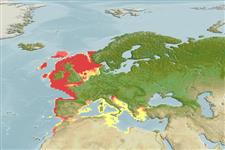Malacostraca |
Decapoda |
Munididae
Environment: milieu / climate zone / εύρος βάθους / distribution range
Οικολογία
; εύρος βάθους 30 - 300 m (Αναφ. 79413). Temperate; 63°N - 30°N, 18°W - 31°E
Eastern Atlantic and the Mediterranean: From Shetland to Sognefjord, Norway in the north to Madeira Is. and the Mediterranean.
Length at first maturity / Μέγεθος / Weight / Age
Γεννητική Ωρίμανση: Lm 1.0, range 2 - ? cm
Epibenthic (Ref. 87524). Inhabits sandy and muddy bottoms (Ref. 105214). Also found on rocky substrates in shelf waters from shallow to deeper continental slope (Ref. 105215) and on Serpula vermicularis reefs (Ref. 122978). In general, galatheid crabs show a wide spectrum of feeding habits, from being detritivorous, vegetarian, omnivorous, to cannibalistic (Ref. 90632).
Members of the order Decapoda are mostly gonochoric. Mating behavior: Precopulatory courtship ritual is common (through olfactory and tactile cues); usually indirect sperm transfer.
Jennings, S., J. Lancaster, A. Woolmer and J. Cotter 1999 Distribution, diversity and abundance of epibenthic fauna in the North Sea. Journal of the Marine Biological Association of the UK 79:385-399. (Αναφ. 3123)
IUCN Red List Status
(Αναφ. 130435: Version 2025-1)
CITES status (Αναφ. 108899)
Not Evaluated
Not Evaluated
Threat to humans
Human uses
αλιεία: Εμπορικό(ά)
| FishSource |
Εργαλεία
Περισσότερες πληροφορίες
Τροφική ΟικολογίαFood items (preys)Σύσταση δίαιταςΚατανάλωση τροφήςΘηρευτές Population dynamicsΑύξησηMax. ages / sizesLength-weight rel.Length-length rel.Length-frequenciesMass conversionΑφθονία PhysiologyΚατανάλωση οξυγόνου
Human RelatedStamps, coins, misc.
Διαδικτυακές πηγές
Estimates based on models
Preferred temperature
(Ref.
115969): 6.9 - 11.3, mean 9.3 (based on 315 cells).
Ελαστικότητα
Υψηλό, ελάχιστος χρόνος για διπλασιασμό πληθυσμού < 15 μήνες (Fec=6,000).
